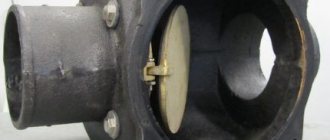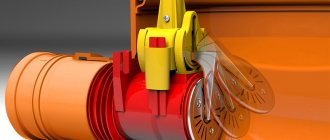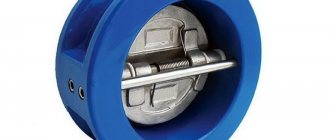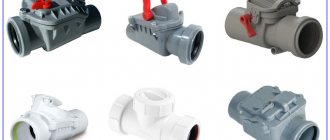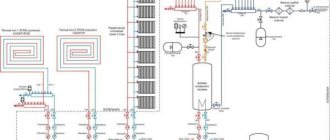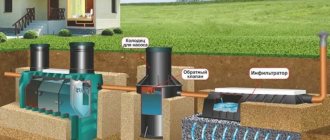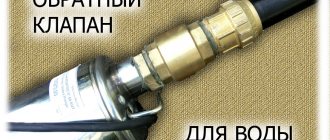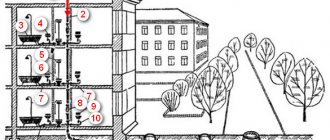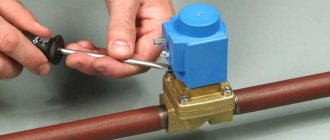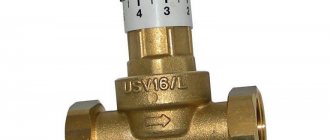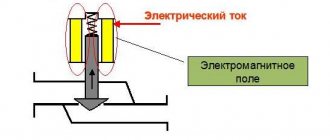What is it and what is it for?
A check valve is one of the elements of protective pipeline fittings.
The main purpose is to prevent changes in the direction of water flow. It automatically closes the pipeline if the flow direction changes in the opposite direction.
Water check valve
Also performs the following functions
- When the water supply is turned off, it prevents its outflow through the riser
- Blocks hot water from entering the cold water supply system and vice versa
- Significantly reduces the likelihood of water hammer
- Increases the operating time of equipment (pumps, meters, etc.)
- Reduces the risk of broken connections in the plumbing system
Is it really necessary?
Installation of a sewer check valve 50 or 110 is not always required; there are certain situations when installing this device does not make much sense. For example, residents of apartments on the 6th floor of an apartment building do not have to worry about possible sewer flooding through the central blockage, because... the pressure of waste fluids will not maintain a high level when rising to the 6th floor.
In general, there are situations when it is strongly recommended to install the device:
- location of the apartment on the first/second floor of a multi-storey building;
- location of office space on the first two floors;
- private 1-storey house;
- cottage-type country house with 2-3 floors.
In the above situations, it is financially more profitable and easier to install a valve on plumbing fixtures in advance than to later repair the premises and deal with the negative consequences of a clogged and broken sewer. It is especially important to install the mechanism in houses with old pipelines. Pipes in such buildings usually have a layer of sediment on the inner walls, resulting in a smaller working area and an increased likelihood of clogging.
Where is it used?
A non-return valve is very useful in the water supply of a private home.
If for some reason the pump stops, it prevents water from flowing back into the well or borehole. In the event of a power outage or pump shutdown, there is no need to refill the system with water.
On water pipes.
The supply of hot and cold water in private and apartment buildings is carried out through different pipes. Sometimes different water pressure causes hot water to fill cold water pipes. The valve allows you to bring the pressure back to normal.
In front of the cold and hot water meter.
Helps protect against damage in the event of a water hammer.
At the inlet to the water heater.
The boiler is filled under pressure. When warming up and pressure increases, the displaced coolant will be directed back into the cold pipe. Prevents churn
Popular ball models
A number of devices that use a metal ball to seal the liquid and have a low cost.
Tim JH-1014
Characteristics:
- body and locking structure material – brass;
- maximum temperature – 130 °C;
- connection type – coupling (BP/BP);
- price – 660 rub.
Valve for use in the installation of hot and cold water supply, heating, transmission of compressed air, gases and liquids that do not interact with the product material. The model has no rubbing surfaces and can be mounted in any position without changing characteristics.
The spherical chamber increases throughput compared to cylindrical counterparts. The operating pressure of the valve is from 0.05 bar.
1″ ALTSTREAM
Characteristics:
- thread type – 1″;
- temperature range – from -20 °C to 150 °C;
- tightness of the locking element - class A;
- material – brass;
- type of flow – full bore;
- price – 400 rub.
The ball design is used to lock pipeline systems for household and drinking purposes, heating, hot water supply, and compressed air. The product has a service life of 30 years and can be repaired. The minimum production resource is 25 thousand cycles.
Operating principle of a check valve
- The flow of water flowing through the pipes under pressure acts on the shut-off element and presses out the spring, which keeps the valve closed.
- After the spring has compressed, the valve opens and water flows freely through it in the desired direction.
- When the pressure in the water supply drops or when water moves in the opposite direction, the spring mechanism of the device moves the valve to the closed state.
- All the actions of the shut-off valve prevent the formation of backflow in the water supply system.
Operating principle of a check valve
Technical characteristics, diameters and manufacturers
Important technical parameters of the device are:
- Diameter. Selected according to pipe dimensions. The diameter can be 5, 7.5 or 11 cm. The first 2 types are installed on intra-apartment systems, the last - on the riser. Some valves can be placed on sewer elements of different sizes. This becomes possible thanks to the introduction of a stepped pipe. On pipes of non-standard sizes, tees with a ventilation valve are installed.
- Bandwidth. This parameter reflects the volume of air entering per second. For 1 l/s of wastewater, up to 25 l/s of gas is required. The valve capacity can reach 37 l/s.
In our country you can purchase vacuum valves manufactured by HL (Austria), McAlpine (Great Britain), Wavin (Poland), Europlast (Ukraine), Ostendorf (Germany).
Design Features
Housing material
The most common material used to make a check valve body is brass. This material is highly resistant to chemicals that may be present in water (mineral salts, oxygen, iron compounds, manganese, sulfur and others).
titanium, cast iron, steel, bronze mainly used in industrial systems
Plastic is used in polypropylene pipelines with water temperatures up to 90 degrees
Rubber or silicone sealing gasket.
Check valve device
Shutter element
It comes in the shape of a ball, cone, or “plate”. Double-leaf check valves are also used in pumping stations and water supply systems. They have a shutter in the shape of two semicircular fragments. Most often made of brass
Return mechanism.
To return the shutter to the closed state, the device has a spring. Stainless steel is most often used to make the spring (an important element of the shutter). But there are also models where, under pressure, the shutter rotates on hinges.
Why is the device needed?
A sewer check valve is a device that is designed specifically to prevent leaks and backflow of water due to clogged sewer lines. Sometimes even a package that accidentally gets into the pipeline leads to blockages and flooding of the apartment.
To protect the room from the reverse movement of sewer system waste, a special valve is installed that operates automatically. A similar mechanism is used not only in offices, cottages, residential buildings and industrial premises, but also in heating and water supply systems (for the pump).
Their operating principle is quite simple: if the waste liquid begins to move in the opposite direction, the locking mechanism stops this movement, as a result of which flooding does not occur.
In most cases, the need to install the device arises in the following situations:
- regular entry of debris and large objects into the sewer system, as well as other violations of operating rules;
- a long period of use of the pipeline, during which a layer of grease with dirt particles has formed on the inner surface. This significantly increases the likelihood of clogging;
- the slope of the sewer pipeline is too large or small, because to ensure free gravity flow of liquid, it is important that a certain speed of movement of the wastewater be maintained;
- bends located at a perpendicular angle to the sewer pipe. As a result, the speed of water movement changes sharply and a water blockage may occur.
If in a multi-storey building with a single riser, residents of first-floor apartments installed a check valve for the sewer system at 50 or 110 millimeters, then flooding with drainage can occur even on the 2nd floor. The liquid will not get further up, because... pressure will most likely cause the blockage to clear.
In country houses, similar locking mechanisms are also often installed. However, then it is recommended to install them on the street, after collecting all the branches of the sewer pipes into a single one.
Types of check valve
Spring (lifting)
Its design is similar to a shut-off valve. With sufficient pressure, the valve rises up, opens the hole, allowing the flow to circulate. At low pressure it falls down onto the seat and the water path is blocked. All this happens automatically.
It is used only on horizontal pipes, with mandatory vertical axial installation.
Advantages of a spring valve. Repair is possible without dismantling, as it has a removable cover. Plus it can be used at high temperatures.
High tightness. Versatility, can be used in both private and industrial water supply systems.
One of the disadvantages of spring valves is sensitivity to dirt and mineral impurities contained in water, which can damage them. But this can be solved by installing a filter.
Ball valve
The locking element in this device is a metal ball. Sometimes the ball is covered with rubber for reliability.
If there is no pressure in the water supply, the ball, under its own weight, tightly blocks the passage hole and prevents the liquid from moving in the opposite direction. When water is supplied, the resulting pressure lifts the ball, opening the way for the water flow.
Ball check valve
Pros. Ball check valves can be installed in vertical and horizontal pipes
Simple design and absence of mechanical components increases service life.
However, it should be remembered that with an equal internal cross-section, the outer dimensions of a ball valve are larger than that of other types of valves.
Rotary or paddle
The valve received this name because of its design.
It is based on a metal disk (“plate”) and an axis with a spring. The axis of rotation is located above the through hole. When open, the disc is parallel to the movement of water; when closed, it is perpendicular. Under fluid pressure, the disc opens. When the pressure drops, the spring is activated, the disk turns and blocks the flow. rotates under fluid pressure. If the pressure drops, the spring is activated and the disk blocks the path of water
The disadvantage is that in valves of large diameter there is a strong impact when slamming, which can lead to rapid failure of the structure.
Rotary check valves are divided into two groups:
Simple - with a small diameter of up to 400 mm. Used in systems where shocks cannot greatly affect the operation of the hydraulic system and the valve itself
Impactless - valves with a special mechanism that ensures smooth closing of the disc. The downside is that they are more expensive.
Double check valve
This device has two locking segments, which are located on a rotating axis. The plates are located in the center of the passage hole.
Water moving in the right direction opens the doors. If the direction of flow changes, the plates, under the action of springs, close the passage of the liquid.
Butterfly valves come in a wide range of sizes so they can be installed on pipes of various diameters.
They are also recommended for installation in systems where high pressure is present.
The best petal varieties
Models of units with one or two blocking plates.
TIM 1 Vn, JH-1012C
Characteristics:
- product type – straight;
- thread diameter – 1 inch;
- body material – brass;
- maximum temperature – 120 °C;
- working pressure – 40 bar;
- type of thread – internal;
- price – 303 rub.
The valve is a petal type, equipped with a horizontal damper. Mounted in heating systems without pump circulation. The device operates at low pressure and does not create strong resistance to water flow, unlike spring units. The shutter has a rubber seal.
TIM 1 1/4 Vn, JH-1013C
Characteristics:
- thread diameter, inch – 1 1/4;
- working pressure – 25 bar;
- material – brass;
- coating - no;
- maximum temperature – 120 °C;
- price – 399 rub.
Petal model for non-volatile and pumpless heating systems, made of reinforced brass for plumbing purposes. Can operate at minimum pressure, is equipped with a threaded connection, and has a 1-year warranty.
Classification by installation method
Flanged valve
With this type of device, the return flange and the supply flange are welded to the valve body and a single structure is obtained.
This type of valve is mainly used in industrial systems for large diameter pipes.
Due to its large size, it can cause water hammer, since at the moment of closing, increased pressure is created in the system. To avoid this, systems use shock-free shutters with soft closing.
Advantages: ability to work in systems with water pollution. Application on main pipelines with large pipe diameters.
Wafer
These devices have virtually no mounting hardware. The valve itself is mounted between two flanges, at the ends of the connected pipes. A special seal is placed at the installation sites. After this, the flanges are tightened together with threaded connections (bolts or studs).
If installed correctly, the valve will be securely fixed. In terms of reliability, this type of connection is almost as good as a flange connection.
Coupled
The most common in household plumbing.
With this connection, the valve is connected to the pipe using a threaded coupling.
Pros: No need to use additional fasteners. Not suitable for large diameter pipes.
How does a vacuum valve work?
It is already clear from the purpose of this device that it must remain closed when there is excess pressure in the sewer pipe or when it is equal to atmospheric pressure.
But if a vacuum occurs in the pipe, the valve mechanism must ensure the opening of the passage for air to enter from the outside. The principle is easily implemented with the “involvement” of ordinary gravitational forces. The diagram below shows the structure of one of the aerator models. Despite possible differences in the design of valves from different manufacturers, the principle remains virtually unchanged.
An example of a device and a demonstration of the principle of operation of a vacuum valve for sewage.
The entire valve mechanism is assembled in a polymer housing (item 1). The device itself implies only a horizontal arrangement, so in its lower part one or another device must be provided for a sealed connection with the sewer pipe. In the example shown, this is an elastic cuff (item 2) for inserting the aerator into a socket or even just into a cut pipe. There may be a connecting unit in the form of a standard sewer pipe socket or other options. But this installation is always simple, reliable and understandable.
Air can enter the aerator through the intake grille or slot-like openings (item 3). They are located at the bottom or on the side of the valve "head", but outside air will almost always be applied to the valve diaphragm from below.
This is very easy to explain. The valve flap (pos. 5) is located in the seat assigned to it (pos. 4) and fits tightly to its edges with an elastic cuff (membrane), preventing air from passing from the pipe into the room. And the fit is ensured by the banal force of gravity of this damper. That is, even if the atmospheric and established pressures in the pipe (riser) are equal, the valve will be closed. This can also be facilitated by some excess pressure in the pipe, since gas formation in the sewer almost never stops. That is, the valve will thereby be pressed even more against the seat (in the diagram it is the left fragment).
But if, for one reason or another, even a slight vacuum is created in the pipe, atmospheric pressure will overcome gravity and lift the valve above the seat. As they say, “nature abhors a vacuum,” and the outside air will rush into the pipe, equalizing the pressure and preventing the siphons from breaking.
To prevent the damper from warping, it may have special guides (item 6). However, many models can do without them - centering is done due to the cylindrical shape of the valve assembly.
Aerator for 110 mm pipe - model with two valve heads. One of them has been disassembled to demonstrate its simple device.
Out of pure curiosity, you can “disassemble” several more vacuum valves of various models. But we still won’t find any fundamental differences there.
The differences in the design of different valve models are not fundamental.
By the way, since the device is being considered, you can immediately draw the readers’ attention to the “Achilles heel” of any valve. This, of course, is the membrane itself, more precisely, that area of it that is pressed by gravity to the valve seat
And here we are not talking about wear (if it exists, it is very unnoticeable), but about other obstacles that can prevent the sash from sealing:
- Over time, dust can accumulate on the valve seat or on the membrane itself, which can turn into hard lumps of dirt that prevent the valve from sealing tightly. Often the owners are notified of this by the “aroma” of sewerage entering the premises. The first thing to do when such a “bell” comes up is to check the cleanliness of the membrane and its fit, and carefully clean the assembly from contaminants.
- The second conclusion is that the vacuum valve must be installed only in a heated room of the house. Otherwise, with the onset of cold weather, drops of condensate may freeze on the seat or on the membrane, and the valve mechanism will not fit properly. And in general, too large temperature changes do not benefit the rubber membrane - it begins to “tan” in the cold, losing the necessary elasticity.
Otherwise, the mechanism is extremely simple, and it is difficult to come up with any circumstances that would lead to a breakdown of the vacuum valve.
Do I need a check valve for a water meter?
If you turn on several taps at the same time in an apartment building, pressure drops will occur in the water supply system. To avoid this, it is enough to install a check valve on the water meter, which will equalize the pressure drops.
The internal space of the meter must be constantly filled with water. This requirement allows the hydraulic check valve to be fulfilled. This will allow the meter to not fail for a long time.
If the pressure in the cold water pipe is greater than in the hot one. The meter will also start counting cold water. This will result in an increase in your utility bill accordingly. The check valve prevents cold water from entering the hot water system.
Valves that reliably block the water flow and prevent movement in the opposite direction. They will help prevent the consequences of water hammer for the water meter. This significantly increases the service life of the device.
Main tasks of the device
It stabilizes the pressure in the system, protects against water hammer, and prevents reverse fluid circulation. If the valve is installed in a submersible pump in front of a well in a summer cottage, it allows the pump to operate without failures or breakdowns.
Where to install
- If necessary, a check valve is installed where it is necessary to ensure flow movement in one direction.
- After the water meter, to protect against water hammer
- On hot and cold water pipes when used simultaneously. Due to the pressure difference, overflow through the mixer is possible
- At the water heater inlet to prevent heated water from escaping into the cold water supply system
- In front of the pump or pumping station to prevent the outflow of water in the event of a power outage or breakdown
- At the very inlet of the suction pipe
- In the anti-drip protection system of the dishwasher and washing machine
Where in the apartment should I install a check valve - video
How to install correctly
The easiest way to install a check valve is through a threaded coupling. Suitable for installation in the water supply system of an apartment or private house.
Work order (step by step instructions)
Select location, see above
Prepare fittings of the required diameter.
Wrap a sealant around the thread (linen, fum tape, thread)
Use a fitting to secure the check valve
Open the tap and check for leaks
If you are unsure or doubt your capabilities, call a plumber
It is important! There is an arrow on the valve body. The direction of the arrow must coincide with the direction of water flow in the pipeline
Even the most reliable shut-off valves fail over time. Therefore, you need to know how to remove the check valve yourself.
- First you need to turn off the water flow with taps
- if necessary, drain from the system
- Then unscrew the nuts.
- Dismantling flanges or fittings
- Remove the check valve.
- If possible, replace failed parts (for example, a spring)
- Reassemble in reverse order.
.
Attention! If the valve is installed near the water meter. You must act carefully so as not to damage the seal installed by the management company.
Installation of valves with a pumping station
When choosing a check valve, it is necessary to take into account its nominal pressure, flow capacity and bore diameter. All this data is contained in the technical passport. You can do the installation yourself, following the instructions for the pumping station. The manufacturer must indicate in it the recommended locations for installing all the necessary fittings.
Option for installing OK on a centrifugal pump:
Image gallery Photo from We select the part according to the size of the hose/adapter (for example, 1 inch), check the workmanship: there are no scratches, chips, or internal damage
The direction in which the water should flow is usually indicated by an arrow. If it is not there, then you can use the blowing method
Screw the check valve onto the adapter. To create a tight connection, use FUM tape or linen strand
To make the connection as strong and tight as possible, tighten the valve using a gas wrench
Step 1 - Selecting and Testing a Check Valve
Step 2 - Determine the correct installation direction
Step 3 - screwing the valve onto the threads of the adapter
Step 4 - tightening with a gas wrench
The main thing here is to find out the presence/absence of a check valve in the pumping station block. If it is already a standard element of the water supply installation, then there is no need to install this additional fittings. In this case, constipation will only reduce the throughput capabilities of the pipes, and there will be no benefit from it. It’s not worth spending money and time on installing an unnecessary element, which will also create even minor difficulties in the flow of water.
The standard installation locations for check valves are the lowest point of the suction pipeline and the entrance to the pressure line immediately after the pumping station
If the design of the water supply system assumes the possibility of emptying the pressure line or operating the pump in reverse mode, then the upper check valve cannot be installed after the water pressure unit. He simply will not allow such actions, blocking the flow of water to the water pumping unit.
The installation sequence of the “valve + valve” combination depends on the pump starting technology. There are models that are initially designed to be launched on a closed valve. In these cases, the check valve must be installed after the shut-off valve.
Manufacturers recommend installing a check valve in the “lower” position in all cases together with a coarse strainer. The water must first be purified from sand. The internal parts of the system will wear out faster from contact with abrasive particles.
It’s better to immediately take a reverse lock with a removable or non-removable mesh. It will protect the device from sand, and you won’t have to install an additional filter.
When choosing an installation point for a check valve, you must consider:
- direction of water flow;
- availability of fittings for subsequent repair and maintenance;
- restrictions on the strict horizontal or vertical installation of certain types of check valves;
- the presence of sand in the water, which can lead to clogging.
Spring check valves with a lifting shut-off element are least susceptible to contamination. The fastest and easiest way to install pipe fittings is with a wafer type connection. But more often, inexpensive analogues with flange or coupling mounting are chosen for water supply systems in private homes.
When using a submersible pump, a check valve is mounted at the end of the pipe lowered into the water intake, in front of the pumping device
When installing a check valve, it is important to install it correctly. The spool axis must be located strictly in a vertical position
And when installing a rotary product, the axis of rotation of the “flap” should always be above the center line of the water flow.
The arrow on its body allows you to control the direction of water flow and the correct location of the check valve. It is difficult not to notice it, and even more difficult to make a mistake with installing the locking device in the desired position.
Possible errors and problems during installation
The device may fail due to installation errors.
During the installation process, be sure to follow the instructions
It is advisable to inspect for problems once a month.
Possible problems:
No water flow
Incorrect installation. The arrow shows the direction of flow.
What to do: Disassemble and unfold the valve
During installation, the plug or the shutter retainer was not removed. This will result in the device not allowing liquid to pass through.
Solution: Dismantle, remove plug or retainer
The valve does not hold well
does not seal tightly.
A solid particle may enter and prevent the passage from being completely blocked.
What to do: First, try to wash off the trapped debris with a stream of water. You need to open and close the nearest shut-off valve several times. If this does not help, disassemble the check valve, rinse it well and reinstall it
The threaded coupling has burst.
This happens when there is a heavy load in the pipeline, a defective product, or too much sealing material is wound.
What to do: Can only be fixed by replacing the product
Tapping
After installing the check valve, knocking noises are heard. This can happen due to the larger valve diameter. Another option: installed too close to the pump.
Solution: in the first case, purchase a device with a smaller diameter. In the second, rearrange it to a more suitable place.
Dry option
The dry seal for sewerage has more advanced characteristics than traditional water seals. This model has a different operating principle; it operates according to the nipple principle. The device is made in the form of a polymer tube with threads on both sides. Polypropylene is most often used to make the model.
Inside the housing there is a special membrane that prevents the reverse movement of water and sewer gases. That is, the membrane performs the functions that a water plug performs in a conventional valve.
If a conventional valve ceases to perform its functions during prolonged inactivity due to the water drying out, then the dry version will function normally under these conditions.
Pros of the option
Advantage of the option:
- the device does not require water supply for normal operation;
- the model can be installed even in unheated rooms, since there is no threat of destruction due to freezing water. This option is suitable, for example, for a summer cottage that is not used during the cold season;
- dry siphons are compact and convenient;
- it is much more difficult to break a dry seal than a water seal;
- eliminate the backflow of dirty water, which can occur when a blockage forms;
- the shutter can be installed both vertically and horizontally;
- water does not stagnate in the shutter, in which harmful bacterial flora can develop;
- has excellent sound insulation;
- has a long service life.
Types
Dry seals are available in several versions, each of them has its own characteristics. Here are the most common options:
- Membrane. This is the simplest and most common option. The valve operates due to a spring membrane, which opens when water flows from the drain hole, but remains closed until the water is used.
- Float This option can be called transitional between dry and water seals. The device is equipped with a float valve. When liquid enters, the float floats up so as not to interfere with the liquid leaving. And after the water leaves, the float falls into place, sealing the lumen of the sewer pipe.
- Pendulum. The valve in such a valve has a single attachment point. When water enters the drain, the pendulum deviates, opening the passage. Then, under the influence of gravity, the valve returns to its place.
- With molecular memory. This is a high-tech option; such shutters are quite expensive. Thanks to new technologies, membrane elements reliably seal the pipe lumen after water stops flowing into the drain.
So, there are different options for water seals for sewerage. The choice of option is made depending on the type of plumbing element, as well as operating conditions. Installation of water seals is a prerequisite for assembling an internal sewerage system. If they are missing or installed incorrectly, an unpleasant sewer smell will certainly appear in the apartment.
Advice and recommendations from experts
To avoid mistakes during installation, we recommend reading expert advice:
- The direction of the arrow on the valve body and the direction of fluid flow in the water supply must match.
- The device must be installed in places where there is easy access. This is necessary so that the check valve can be inspected or repaired in the future.
- Before installation, check the device for leaks.
- Valves made of steel and brass have a longer service life. Since they are more resistant to corrosion and pressure changes.
- It should be installed after the metering device.
So that the water check valve installed in the water supply system can function correctly for a long time. It is necessary to carry out installation according to the rules specified in the instructions
Installation of a water seal
Installing a siphon does not cause any problems. First, install a grill to protect the sewer from large particles, then screw the device to the outlet using a nut. Then put the siphon on the drain pipe and fix it.
Connecting a siphon to a bathroom is not much different from the previous one. The only difference is the connection of the overflow pipe. But there shouldn’t be any difficulties here either.
In conclusion, it is worth saying that without a water seal, the sewage system will only cause problems. In order for it to work effectively and for a long time, periodically clean it of sediment and rinse it.
Video: Dacha Sewerage. How to do it. Water seal;
How to choose a device
It is important to pay sufficient attention to the process of selecting a check valve model for sewerage. First of all, you will need to analyze your sewer system. It is on the basis of its features that it is necessary to select a suitable valve model.
You need to focus on the following parameters:
- pipe section;
- material of manufacture;
- device dimensions;
- connection method – horizontal or vertical;
- quality level, warranty period;
- complexity of installation.
